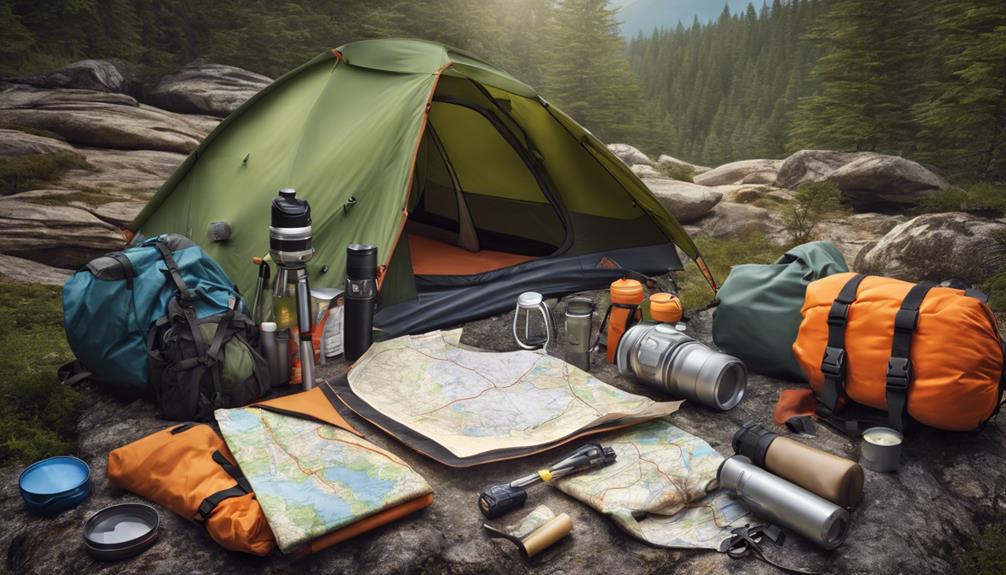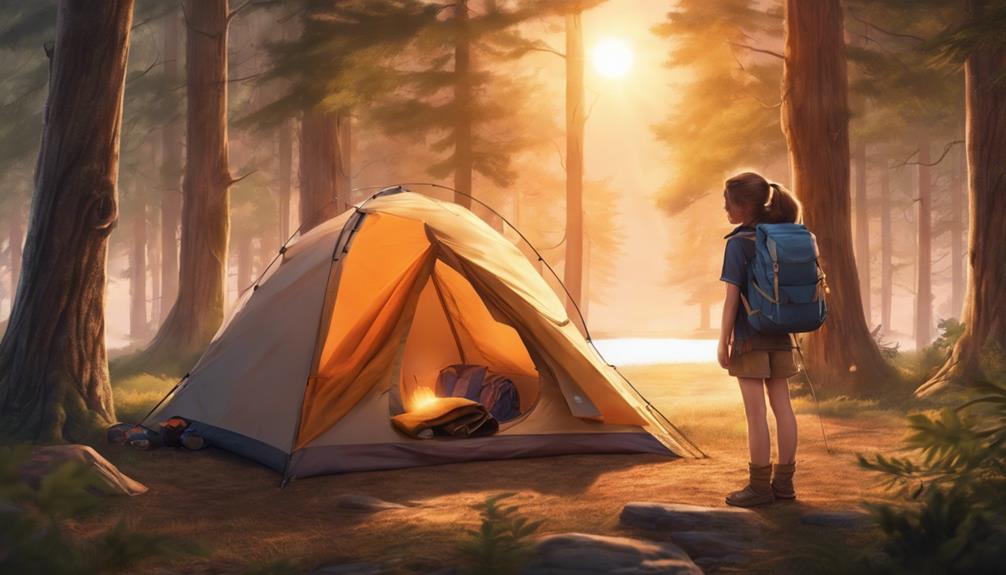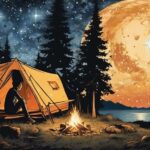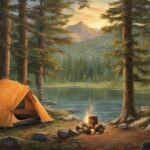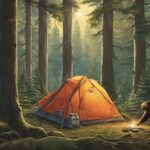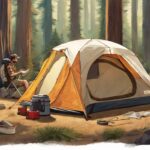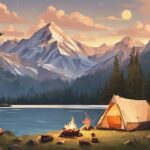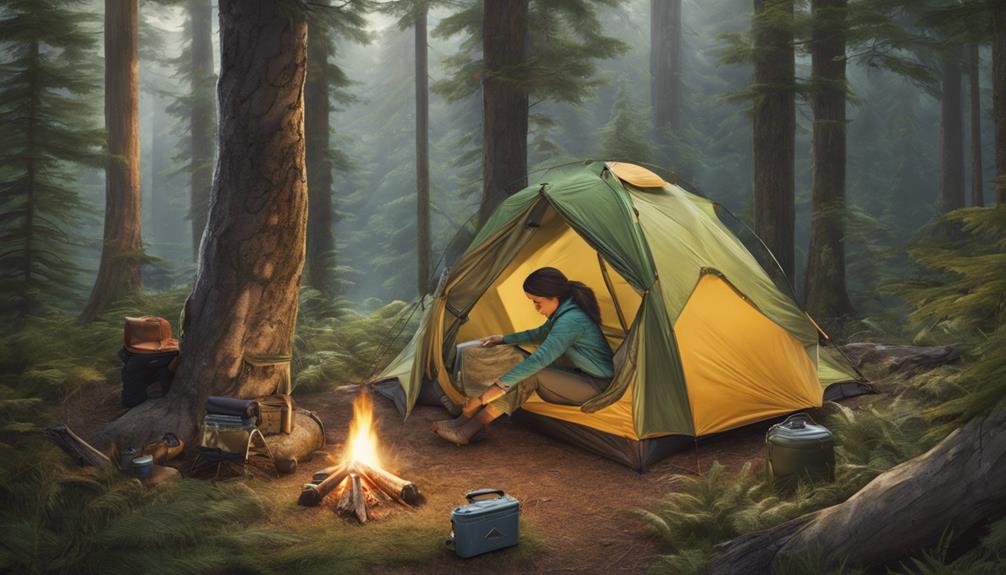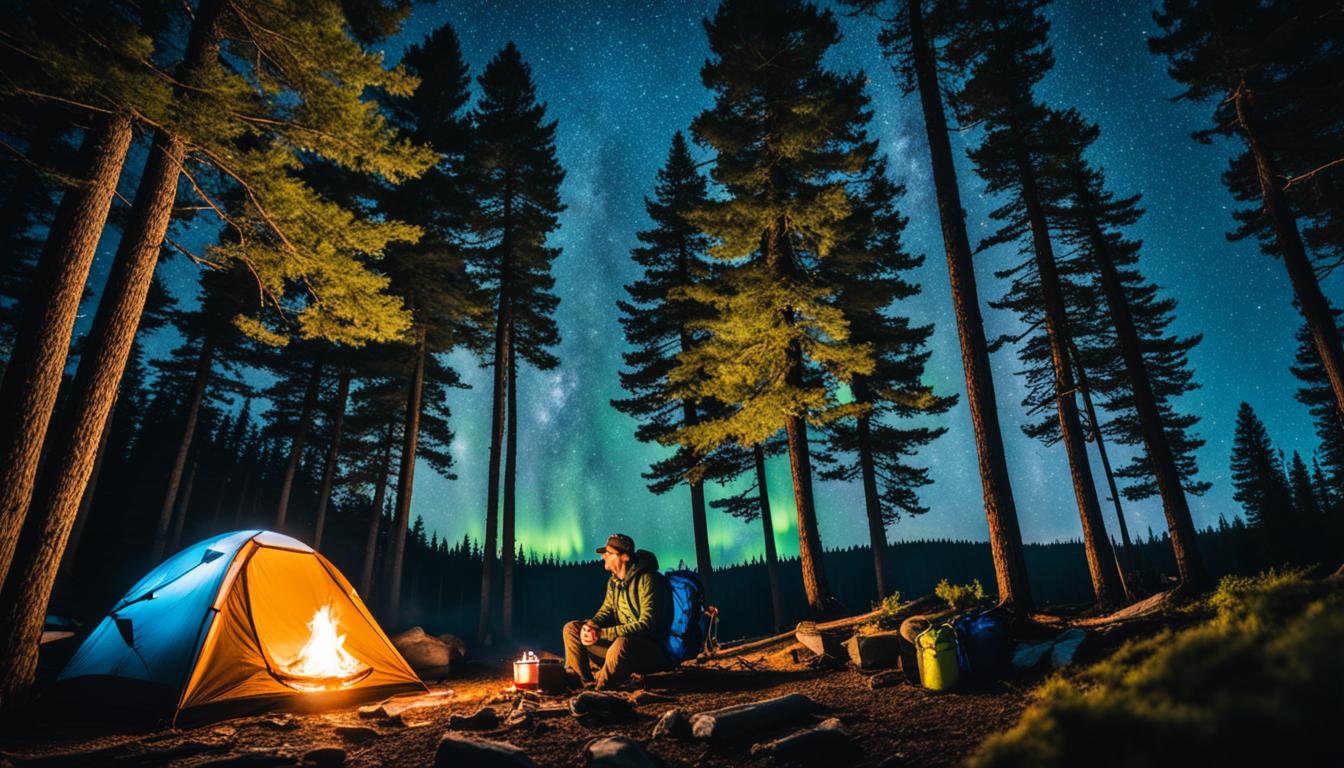When embarking on a solo camping trip, our main focus is on finding the perfect campsite with stunning views, privacy, amenities, and safe surroundings. It is essential to pack necessities such as a dependable sleeping bag, a well-stocked first aid kit, an ample supply of food and water, gear suitable for the weather, and comfort items. Mapping out the route includes studying trails, getting familiar with terrain characteristics, identifying landmarks, preparing for water crossings, and bringing wildlife deterrents for safety.
Sharing our plans with a trusted person, providing a detailed itinerary, sharing emergency contacts, updating whereabouts regularly, and conveying the expected return time is vital. Checking the weather consistently, making informed plans, packing smartly for weather changes, raising safety awareness, and ensuring a delightful experience are all essential steps for a successful solo camping trip.
Key Takeaways
- Prioritize safety and comfort above all else.
- Pack light but include all essentials.
- Inform someone of your itinerary.
- Check weather conditions beforehand.
- Choose a suitable and scenic campsite.
Choosing the Right Campsite
When selecting a campsite for your solo adventure, prioritize factors like stunning scenery, privacy, amenities, and accessibility to ensure a successful and enjoyable trip. Camping solo requires careful consideration of the campsite to guarantee both safety and comfort.
Look for campsites that offer amenities such as restrooms, water sources, and trash disposal facilities. These amenities can enhance your camping experience while ensuring basic needs are met. Additionally, assess the terrain for flat and safe areas without hazards like cliffs or flood-prone zones. Choosing a campsite near trails, lakes, or other attractions can provide added adventure opportunities during your solo trip.
Ensuring safety is paramount when camping alone, so opt for campsites that are well-maintained and secure. Consider the proximity of your chosen campsite to other campers or park rangers for added peace of mind. Prioritizing comfort involves selecting a campsite that allows you to relax and unwind in nature without unnecessary disturbances.
Packing All the Essentials
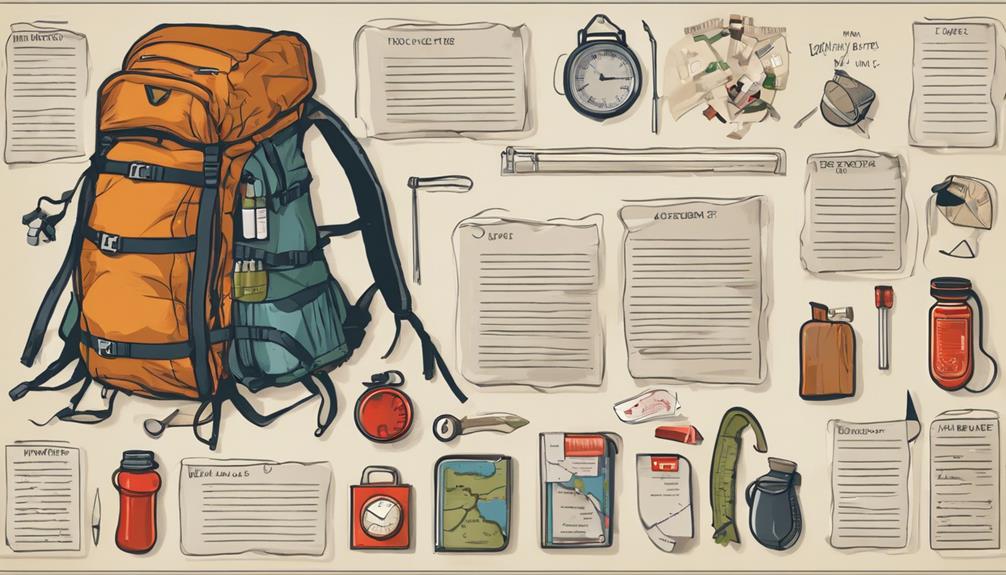
As we prepare for our solo camping adventure, ensuring we pack all the essential items is crucial for a successful and comfortable trip. When embarking on your first solo camping trip, your camping checklist should include key items such as a reliable sleeping bag to keep you warm during the night, a well-equipped first aid kit for any emergencies, and most importantly, enough food and water to sustain you throughout your journey. Here is a table summarizing the essential items to pack for your solo camping adventure:
| Essential Items | Description |
|---|---|
| Sleeping Bag | Ensure it is suitable for the weather conditions. |
| First Aid Kit | Include bandages, antiseptic wipes, and medications. |
| Food and Water | Pack non-perishable food items and an adequate supply of water. |
Planning Your Route
In planning our route for the solo camping trip, we carefully research the trails and obtain a detailed map of the camping area to ensure thorough route familiarity. Understanding the terrain features and prominent landmarks along the way is crucial for effective navigation.
When planning our route, we consider potential obstacles such as water crossings and steep climbs, preparing mentally and physically for these challenges. Being cautious of wildlife in the area, we pack necessary deterrents like bear spray to ensure our safety during the journey. Additionally, we make sure to stay prepared with a GPS device or map, minimizing the risk of getting lost in the wilderness.
By taking these precautions and thoroughly planning our route, we can confidently embark on our solo camping adventure, knowing we're well-equipped to handle whatever comes our way.
- Research trails: Ensuring we're familiar with the paths we'll be taking.
- Know terrain features: Understanding the landscape to anticipate challenges.
- Identify landmarks: Using key points to navigate effectively.
- Prepare for water crossings: Being ready for potential obstacles.
- Pack wildlife deterrents: Ensuring safety in areas with wildlife.
Sharing Your Plans
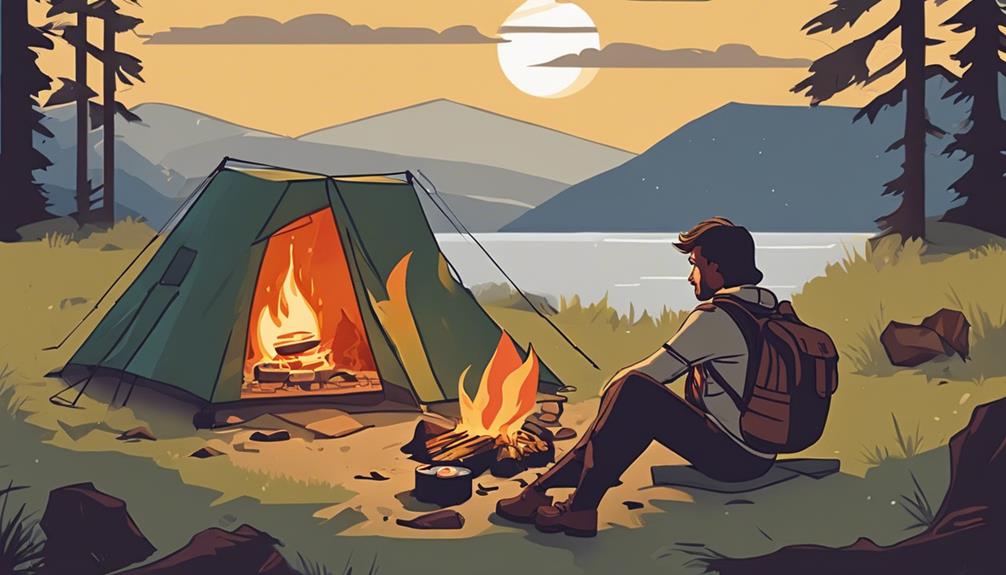
To ensure a safe solo camping trip, it's essential to inform a trusted individual about your plans and provide them with detailed information on your itinerary and emergency contacts. Sharing your plans with loved ones is a crucial step in ensuring a safe and enjoyable trip. Start by discussing your camping location, duration of stay, and activities planned. It's important to provide your emergency contacts and any relevant medical information to your designated person. Regular updates on your whereabouts and any changes in plans should be communicated promptly.
In the case of an emergency, having someone who knows your plans can be a lifesaver. Make sure to share your expected return time with your contact person for safety reasons. This simple yet critical step can make a significant difference in your overall safety while embarking on a solo camping adventure. By sharing your plans with a trusted individual, you add an extra layer of security to your trip.
Checking the Weather
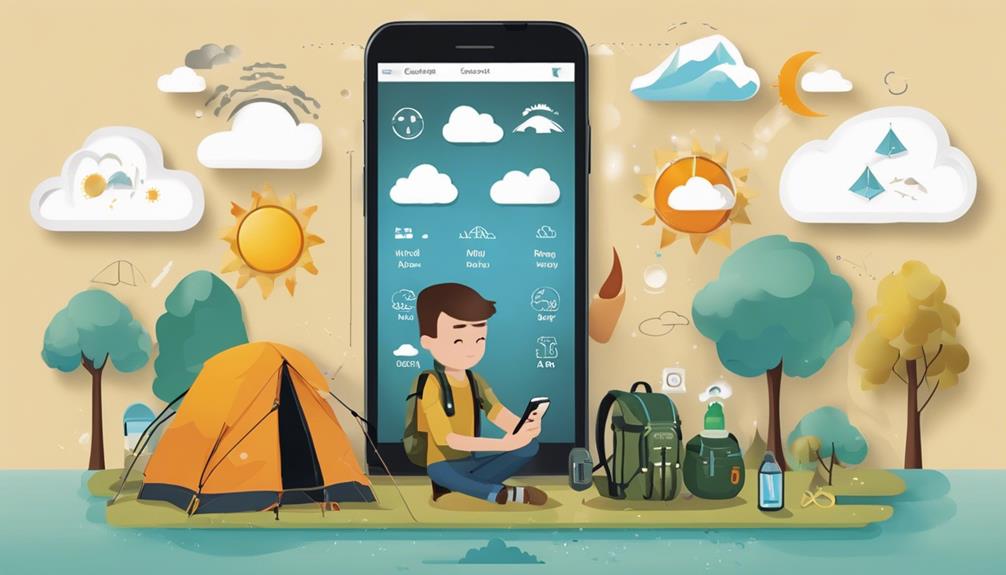
Before setting off on your solo camping adventure, ensuring you check the weather forecast is a key step in preparing for a successful trip. Weather can have a significant impact on your camping experience, affecting everything from your comfort to your safety. Here are some essential tips to help you navigate the weather forecast effectively:
- Stay Updated: Monitor reliable sources for the most current weather information to make informed decisions.
- Plan Ahead: Understand how different weather conditions can impact your camping activities and safety, and adjust your plans accordingly.
- Pack Wisely: Be prepared for any weather changes by packing appropriate clothing, gear, and supplies to keep you comfortable and safe.
- Enhance Safety: Remember that being aware of the weather forecast can enhance your safety during solo camping, allowing you to anticipate and mitigate potential risks.
- Enjoyment Factor: By preparing for the weather, you can ensure a more enjoyable and stress-free camping experience, making the most of your time in nature.
Frequently Asked Questions
What to Do on a Solo Camping Trip?
When we embark on a solo camping trip, we immerse ourselves in activities like hiking, fishing, and stargazing. We bring along entertainment like books or radios for unwinding after a day of exploring. Tailoring our activities to personal preferences, be it photography or journaling, enriches the experience.
Embracing solitude fosters self-reflection, leading to personal growth and introspection. It's all about finding peace in nature and connecting with ourselves.
What Do I Need for a Successful Camping Trip?
When preparing for a successful camping trip, we need to focus on essential gear and supplies.
A high-quality tent, sleeping bag, and pad offer comfort and insulation.
Bring a camping stove, utensils, and food for meals.
Don't forget a headlamp for lighting and a first aid kit for emergencies.
Prioritize these items to ensure a smooth and enjoyable solo camping experience.
What Is the Best Camping Gear for One Person?
When camping solo, the best gear ensures a smooth trip. A high-quality tent, like the Coleman Flatwoods II 4-person tent, offers ample space for one.
Essential items include a warm sleeping bag, sleeping pad, camping stove, and cooking utensils. Don't forget a headlamp or flashlight for nighttime visibility.
A first aid kit and water filtration system are crucial for emergencies. Choosing the right gear is key for comfort and success on a solo camping adventure.
How Do I Prepare Myself for Camping?
When preparing for camping, there are several key steps to ensure a successful experience:
- Research the area and understand the surroundings.
- Make a checklist of essentials and have the right gear.
- Pack food and water for sustenance during the trip.
- Inform someone of your plans for safety purposes.
- Bring navigation tools like a GPS or map for guidance.
These steps are crucial for prioritizing safety, being well-prepared, and enjoying a camping adventure, whether alone or with others.
What Are the Key Tips for a Successful Solo Camping Trip in California?
When embarking on a solo camping trip in California, it’s important to follow some essential solo camping tips for California. First, pack light and bring only the necessary gear. Second, familiarize yourself with the local wildlife and weather conditions. Finally, let someone know your itinerary and expected return date for safety purposes.
Conclusion
So, before you head out on your solo camping adventure, remember to double-check your gear, pack smart, and stay safe. With these tips in mind, you'll be well-prepared to enjoy the great outdoors on your own.
Can you imagine the sense of accomplishment and peace that comes from a successful solo camping trip? It's an experience like no other.
So go out there, explore, and make memories that will last a lifetime.

